Daphne Sheldrick Elephant Orphanage
Daphne Sheldrick Elephant Orphanage, also known as the David Sheldrick Wildlife Trust (DSWT) Nairobi Nursery, is a sanctuary dedicated to rescuing, rehabilitating, and reintroducing orphaned elephants back into the wild.
It is part of the Sheldrick Wildlife Trust (SWT), an organization founded in 1977 by Daphne Sheldrick in memory of her late husband, David Sheldrick, who was a renowned naturalist and founding warden of Tsavo East National Park.
What is the purpose of the Daphne Sheldrick Elephant Orphanage?
The primary mission of the orphanage is to rescue and care for baby elephants that have lost their mothers due to poaching, human-wildlife conflict, or natural causes. The orphans are cared for at the Nairobi Nursery until they are strong enough to be moved to reintegration units in Tsavo National Park, where they can gradually return to the wild.
The facility also plays a broader conservation role, raising awareness about elephant conservation and anti-poaching efforts. In addition to elephants, the orphanage rescues other wildlife species like rhinos and giraffes.
Where is the Daphne Sheldrick Elephant Orphanage located?
The Daphne Sheldrick Elephant Orphanage is located within Nairobi National Park, right on the outskirts of Nairobi, Kenya’s capital city. Specifically, it’s situated about:
✓ 20 minutes drive from the Karen suburbs
✓ 20 minutes drive from Nairobi Wilson Airport
✓ 17 kilometers (10.5 miles) south of the Nairobi city center
✓ 45 minutes drive from Jomo Kenyatta International Airport
The orphanage is located off Magadi Road, near the KWS (Kenya Wildlife Service) Central Workshop Gate of Nairobi National Park. Its location provides easy access for both tourists and locals.
What is the best time to visit the orphanage?
The orphanage opens its doors to visitors at 11:00 AM, which is the optimal time for a visit. To make the most of your visit, try to arrive by 10:30 AM, as this will give you ample time to settle in and find a good spot to witness the elephants’ midday feed and mud bath. It’s recommended to secure your preferred date at the earliest opportunity, particularly for weekend visits, as slots can quickly fill up.
How do I book a visit to the Elephant Orphanage?
The Nairobi Nursery welcomes visitors every day from 11 am to 12 noon, except on the 25th of December. Reservations must be made in advance through our reservations office. Kindly visit our Daphne Sheldrick Elephant Orphanage Visit page for all the relevant information. On this page, you will find a detailed guide covering:
✓ On-site visitor protocols
✓ What to expect during your visit
✓ Directions to the Nairobi Nursery
✓ Pre-booking requirements and steps
✓ The Daphne Sheldrick Elephant Orphanage entry donation
✓ Additional KWS park fees (now required for all Nursery visitors by KWS)
Note: As of September 19, 2023, the Kenya Wildlife Service (KWS) mandates that all visitors to the Daphne Sheldrick Nairobi Orphanage must pay the Nairobi National Park entry fee, even if they don’t plan to explore the park itself.
Since the fee is required, visitors are encouraged to follow up their nursery visit with a game drive through Nairobi National Park, offering a chance to see a range of wildlife, including rhinos, lions, leopards, buffaloes, giraffes, and zebras in this renowned “World’s Wildlife Capital.”
If you have further questions, Kindly email us for a visit at [email protected] for assistance.
How do I visit the Daphne Sheldrick Elephant Orphanage?
Sheldrick Orphanage is a 45-minute drive from the city of Nairobi. It is inside Nairobi park. A team of people takes care of orphaned calves here. Visits are allowed for an hour from 11 am to 12 pm when they bring the youngest inmates to a cordoned-off area for their daily mud bath where they bottle-feed the hungry infants.
People are free to watch, get close, or even touch them but are not allowed to feed them. The keepers tell stories about how the elephants are faring and how the former orphans are progressing. The proceeds from souvenir sales at the shop go directly to support the work of the orphanage.
What happens during the Public visit to the orphanage?
The public visit is timed around our Nursery herd’s midday milk feed and mud bath. From a variety of viewing areas, you will see the orphaned elephants run out of the forest in groups for their much-loved bottles of specialist milk formula.
Afterward, all the orphans gather for playtime. Some wallow in the mud, while others challenge their friends to a wrestling match or indulge in a dust bath. Each day is unique among our Nursery herd.
One of our senior Keepers leads the public visit, introducing you to each orphan, sharing a bit about their stories and personalities, and teaching you about our wider conservation work across Kenya. We always set aside time for questions at the end.
How do I book the private visit to the Elephant Orphanage?
Thank you for showing interest in our private visit to the Daphne Sheldrick Elephant Orphanage. They are suitable for a private group/guests. The experience usually lasts 1 hour between 1500 hours and 1600 hours. Kindly email us for a visit at [email protected] for assistance.
Can I adopt an animal from the orphanage?
Yes, People are allowed to adopt elephants for a fee of $50/- a year. The orphanage provides an adoption certificate as well as up-to-date details about the status of the elephant on an ongoing basis.
The private session between 3 pm to 4 pm needs booking which allows the adopters some private time with their animals. With special permission, adopters can visit the sleepy elephants going to bed.
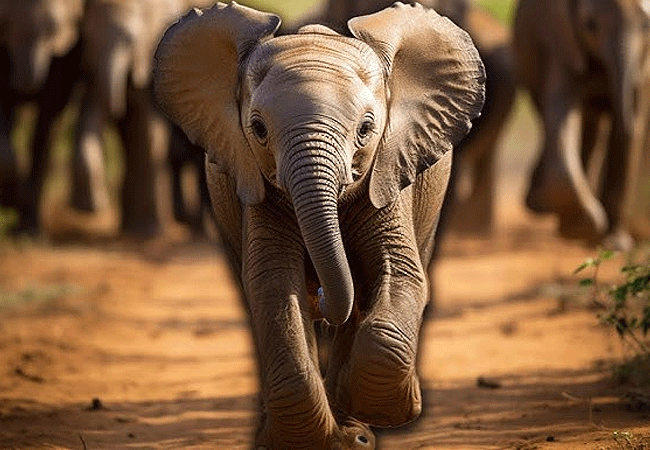
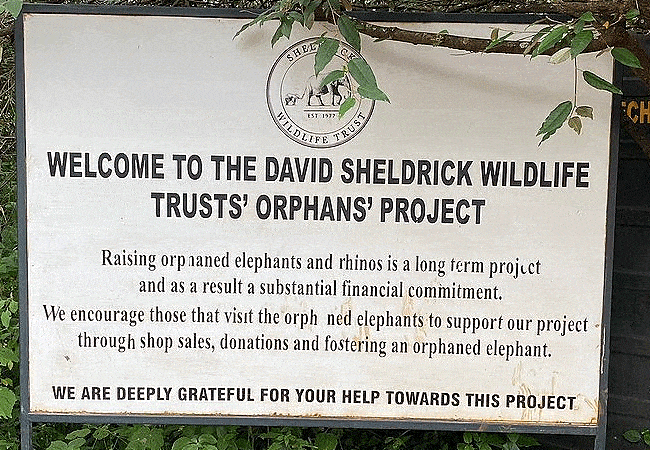

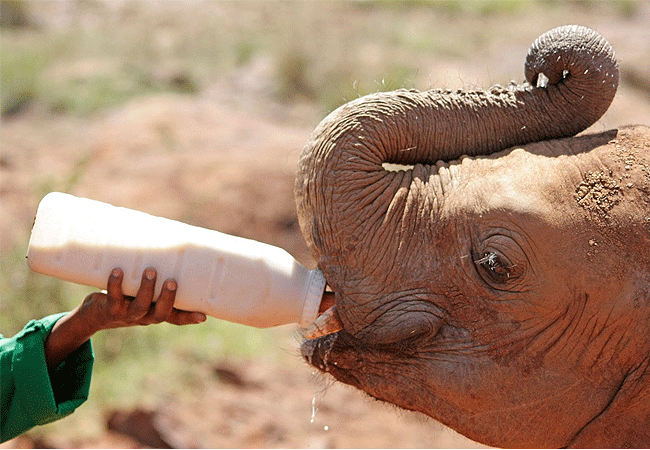


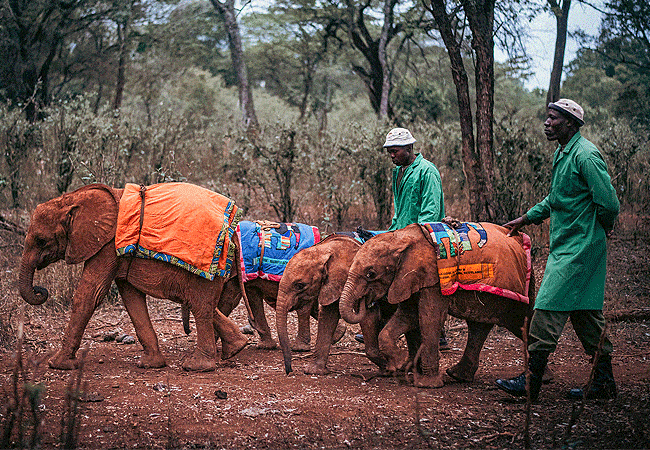
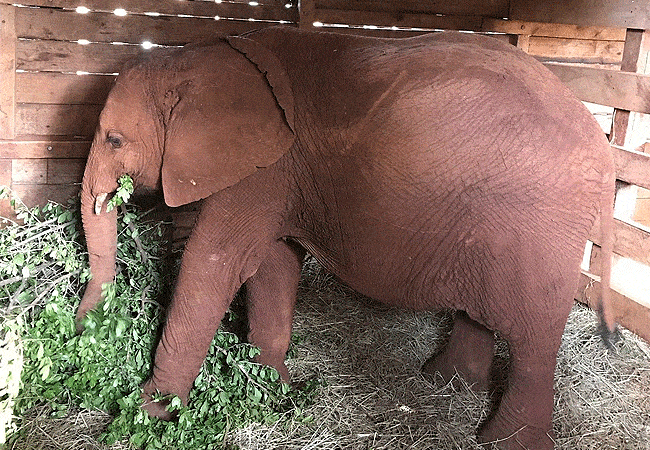

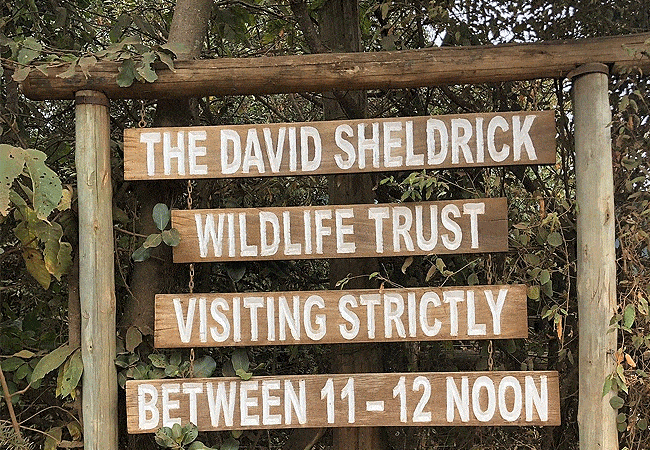

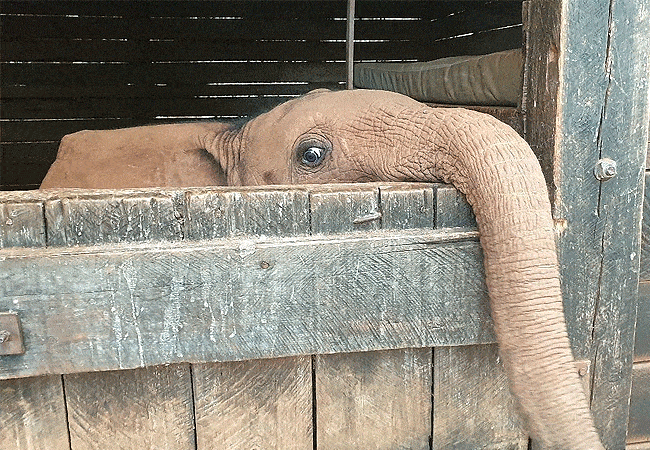

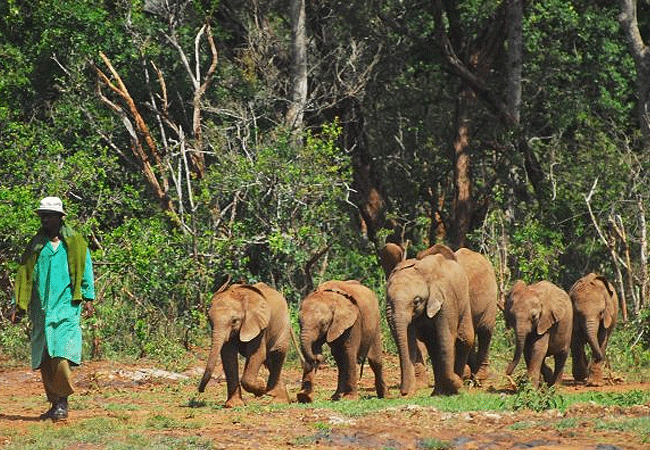
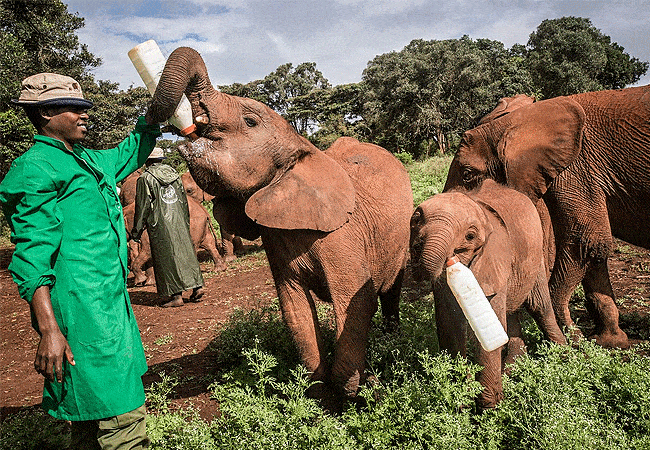



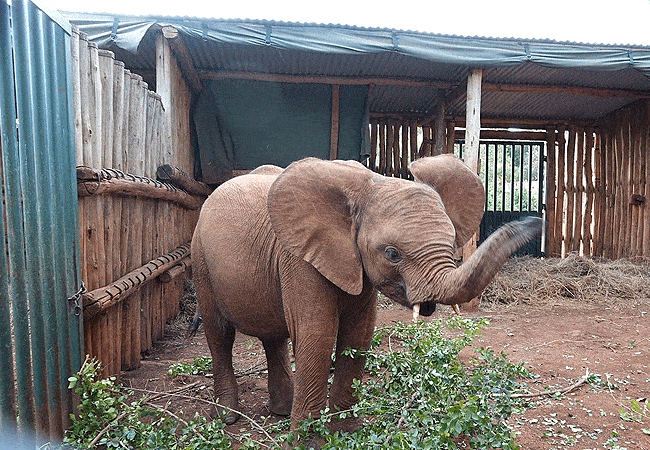
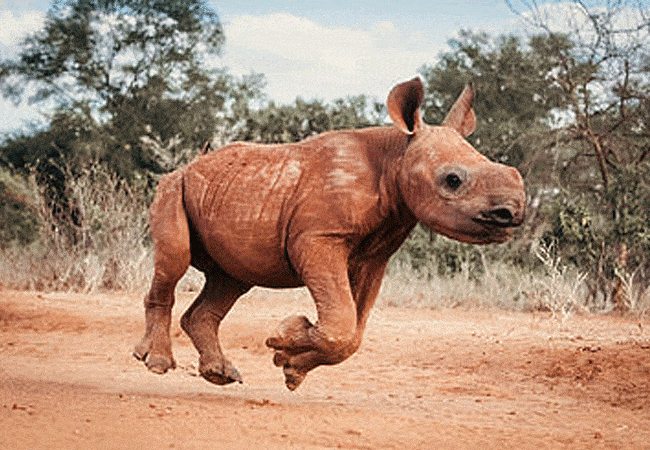
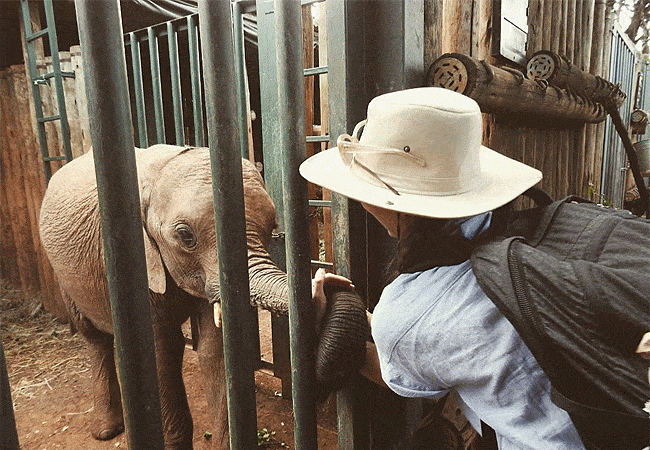
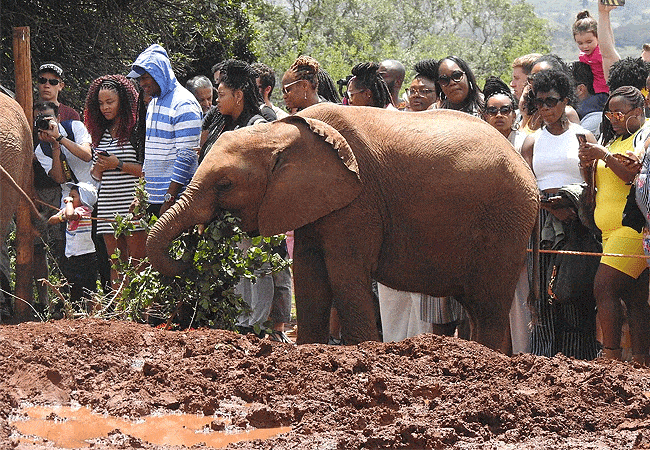

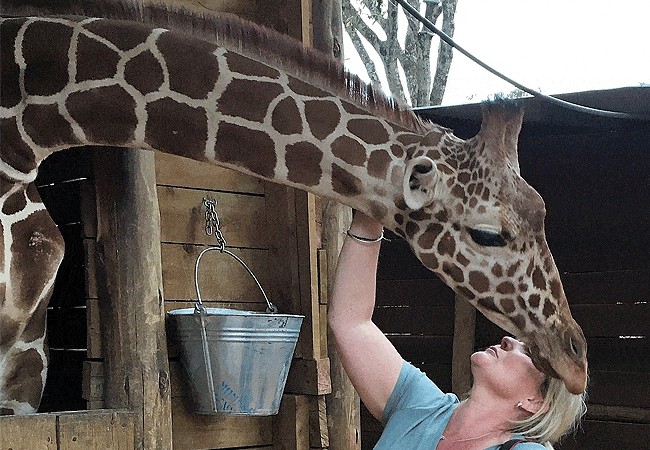
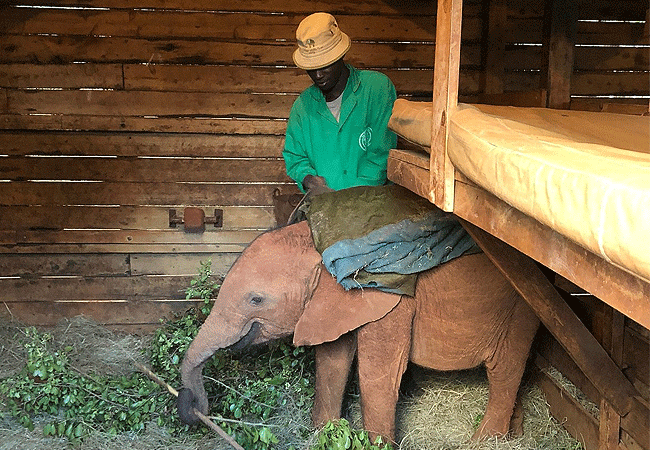
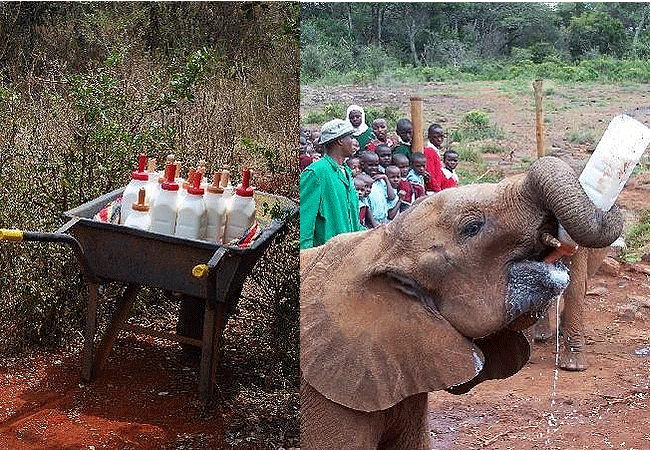
Daphne Sheldrick Elephant Orphanage Private Visit (1500 hours and 1600 hours)

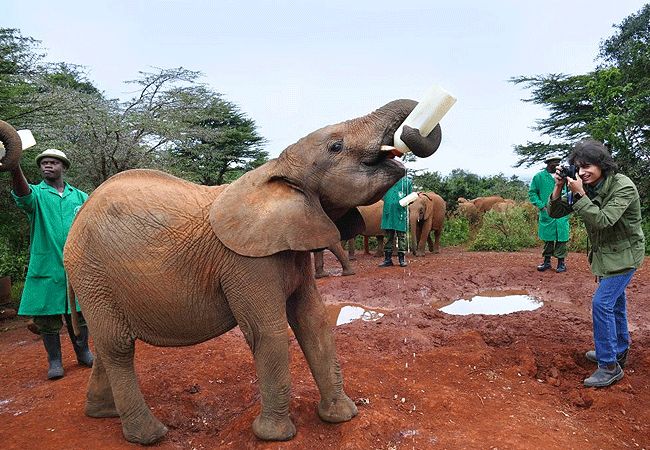

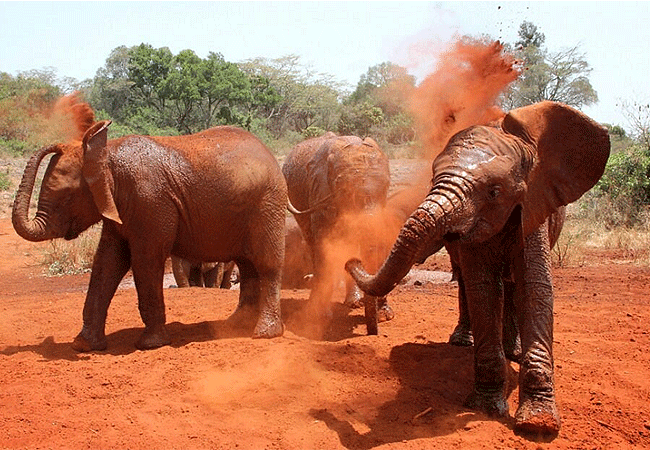
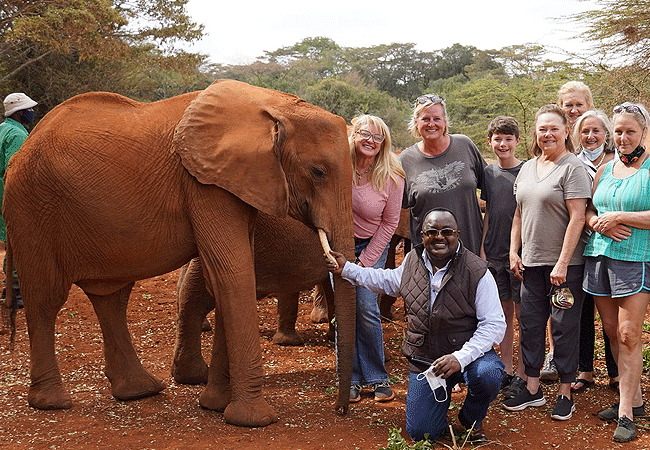
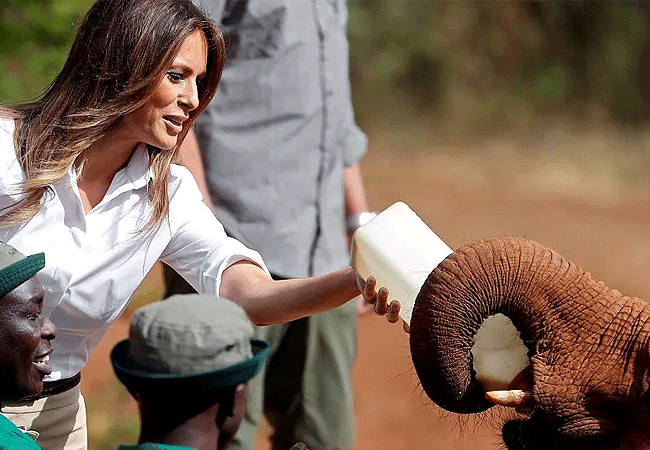
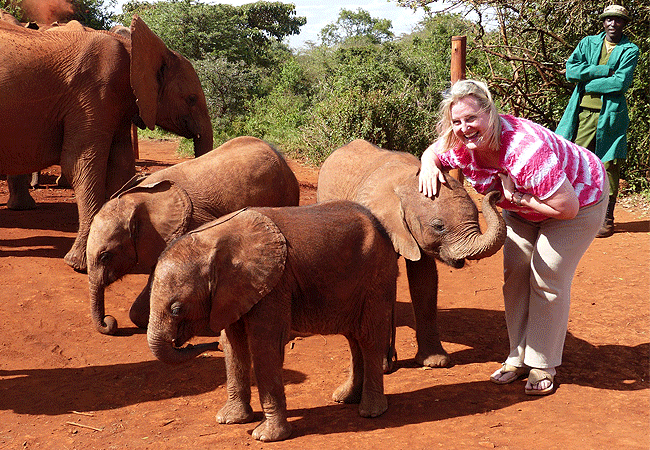

Daphne Sheldrick Elephant Orphanage Activities
Elephant Feeding Sessions
The feeding sessions at the Sheldrick Elephant Orphanage in Nairobi are a heartwarming and unique experience, offering visitors a chance to see baby elephants up close. These sessions take place daily from 1100 hours to 1200 hours.
During this hour, the orphaned elephants, most of whom have been rescued from tragic circumstances such as poaching or habitat loss, are brought out to a designated area where they are fed milk from large bottles by their keepers.
Visitors are roped off to ensure the elephants remain undisturbed as they enjoy their milk and play in mud baths. The keepers often provide fascinating commentary, sharing stories about the elephants’ backgrounds, their rescue operations, and the Sheldrick Wildlife Trust’s conservation efforts. The elephants sometimes come close to the ropes, allowing visitors to pet them, adding a personal touch to the experience.
These feeding sessions are not only an opportunity for the elephants to get vital nutrition but also a time for them to socialize and bond, both with each other and with their human caretakers. For visitors, it is a wonderful way to support the Trust’s work, as the funds raised from these sessions contribute to the conservation of elephants and other wildlife.
Elephant Mud Bath
Following the feeding session, the elephants often participate in a mud bath, a natural behavior that helps them cool off and protect their skin from parasites. Visitors can watch this playful and messy activity from a designated viewing area.
The sight of young elephants rolling and splashing in the mud is both entertaining and educational, highlighting their natural behaviors and the importance of environmental enrichment for their well-being.
Adoption
Adopting an elephant also brings some extra perks. There is an additional hour in which you can visit the orphans 17:00 – 18:00. Visitors can see orphans running back to the stockades for their milk feed. Once they are inside their stockades, they can then go ‘door to door’ to see them. This is a more personal experience than a public visit
Fostering one elephant covers access for a couple, an individual, or a family of two parents and two children of school age. Please note that you can’t adopt an elephant on the day. This has to be done in advance of your visit.
Nursery Tour
The Nursery Tour at the Daphne Sheldrick Elephant Orphanage, part of the Sheldrick Wildlife Trust, offers an intimate and educational experience that showcases the vital work done to rescue and rehabilitate orphaned elephants. The tour takes visitors through the orphanage, where they can see how the young elephants are cared for, including their feeding routines and their gradual rehabilitation into the wild.
During the tour, visitors can observe the baby elephants being bottle-fed, a process critical for their survival since they rely on their mother’s milk for the first two years of life. The calves also indulge in playful activities like mud baths, which are not only entertaining to watch but are also essential for cooling their skin and warding off parasites. The mud baths offer great photo opportunities and highlight the elephants’ social behavior.
A key part of the tour is the keeper talks, where the dedicated staff share stories about each elephant’s rescue, personality, and rehabilitation journey. The keepers also explain the conservation challenges faced by elephants in the wild, including poaching, habitat loss, and human-wildlife conflict.
This informative session gives visitors a deeper understanding of the orphanage’s broader mission and the intricacies of hand-raising these magnificent animals. At the end of the tour, visitors can stop by the orphanage’s gift shop, where proceeds from purchases directly support the orphanage’s efforts.
Keeper Talks
Throughout the day, there are keeper talks where the dedicated staff share their experiences and knowledge about the elephants and the orphanage’s work. These talks offer in-depth information about each elephant’s background, the orphanage’s history, and the conservation challenges faced in Kenya. The keepers provide personal anecdotes and answer questions from visitors, enriching the educational experience.
Educational Presentations
The educational presentations at the Daphne Sheldrick Elephant Orphanage are a core part of the experience for visitors. These presentations are designed to offer insights into the orphaned elephants’ rehabilitation journey, which begins with their rescue and continues through their eventual reintegration into the wild.
During these sessions, visitors learn about the tragic circumstances that led to the elephants being orphaned, often as a result of poaching or human-wildlife conflict. The caregivers share details about how each elephant is cared for, including the feeding process, their medical treatments, and the emotional support they receive. The aim of the presentation is not just to inform but to foster a deeper understanding of the complexities of elephant conservation and the work being done to protect this endangered species.
The presentations also highlight the unique aspects of elephant behavior, such as their social structures, emotional intelligence, and long-term memory. Visitors come to appreciate the importance of family bonds within elephant herds, as well as the challenges these orphans face in adapting to life without their mothers.
Sheldrick Wildlife Trust
What is the history of the Sheldrick Wildlife Trust
The Sheldrick Wildlife Trust was founded in 1977 by Dr. Dame Daphne Sheldrick in memory of her husband, David Sheldrick, a renowned naturalist and the first Warden of Tsavo East National Park. David Sheldrick began his career in 1948 with the Royal National Parks of Kenya, where he played a pivotal role in transforming Tsavo into Kenya’s largest and most famous national park. His legacy as a pioneering park warden continues to be celebrated.
Daphne Sheldrick, born in Kenya, worked alongside her husband for over 25 years, raising and rehabilitating various wild species at their home in Tsavo. She became an international authority on wildlife care, particularly known for developing the formula needed to successfully rear orphaned elephants and rhinos.
Following David’s death, Daphne and her family continued their conservation work in Nairobi National Park, establishing the David Sheldrick Wildlife Trust and its pioneering Orphans’ Project. Daphne’s daughter, Angela, who worked with her mother for two decades, now leads the Trust with her husband, Robert Carr-Hartley, and their two sons, continuing the family’s legacy of wildlife conservation.
How does the Sheldrick Wildlife Trust conserve the wildlife?
The Sheldrick Wildlife Trust, founded by a family passionate about Kenya’s wilderness, is a leading conservation organization in East Africa. Best known for its successful orphaned elephant rescue and rehabilitation program, the Trust has expanded its efforts over the past 46 years to adopt a comprehensive approach to wildlife conservation.
In addition to the Orphans’ Project, the Trust runs Aerial, Anti-Poaching, and Mobile Veterinary Units to protect wildlife and respond to animals in need. Their work includes rescuing orphaned elephants, rhinos, and other species, to release them back into the wild. The organization also engages with local communities through outreach programs and works to secure vital habitats to ensure wildlife has space to thrive.
Collaborating with the Kenya Wildlife Service, Kenya Forest Service, and local communities near national parks, the Trust focuses on reducing human-wildlife conflict and fostering a sustainable future for both people and wildlife.
Where is the Sheldrick Wildlife Trust located?
While the headquarters are located in Nairobi, they also have conservation projects in,
Tsavo
Tsavo – a combination of the Tsavo East National Park & Tsavo West National Park spanning 60,000 sq. km, boasts a diverse environment of lava flows, comiphora woodlands, savannah, swamps, and Lake Jipe.
The area is home to a wide array of wildlife, including elephants, black rhinos, oryx, gerenuk, kudu, zebras, elands, gazelles, buffalo, lions, leopards, cheetahs, painted dogs, and the rare hirola, along with over 500 bird species.
Major threats include ivory and bushmeat poaching, livestock incursions, charcoal burning, and habitat loss due to resource conflict. The Sheldrick Wildlife Trust (SWT) supports Tsavo through anti-poaching operations, mobile vet units, aerial surveillance, the Orphans’ Project, habitat conservation, eco-lodges, and community outreach programs.
David Sheldrick, the park’s founding Warden from 1949 to 1976, transformed Tsavo into a world-renowned park known for its red-dusted elephants. Despite poaching reducing the elephant population to 6,000 in the 1980s, numbers have since rebounded to around 12,000, with the Ithumba Reintegration Unit playing a key role in their recovery.
Meru
Meru National Park, located in Meru and covering 870 sq. km, is an ecologically rich area featuring acacia woodlands, grasslands, and forests that support 13 rivers running through the park.
It is home to diverse wildlife, including rare species like the Grevy’s zebra, elephants, black and white rhinos, cheetahs, leopards, lions, and over 427 species of birds. However, the park faces threats from ivory and rhino horn poaching as well as commercial bushmeat poaching.
Conservation efforts by the Sheldrick Wildlife Trust (SWT) and Kenya Wildlife Service (KWS) include anti-poaching operations, a mobile veterinary unit, and extending the electric fence for the Meru Rhino Sanctuary.
Founded in 1966, the park became famous as the home of Elsa the lioness. Despite a decline in wildlife due to poaching in the 1980s, reintroduction efforts have restored populations of several species, and the park now protects over 80 rhinos in the Meru Rhino Sanctuary.
Amboseli
Amboseli National Park, covering 390 sq. km, features a diverse environment of wetlands, savannahs, and woodlands. It is home to abundant wildlife such as elephants, cheetahs, giraffes, lions, zebras, elands, wildebeests, and Thompson’s gazelles, along with over 600 species of birds.
The region faces significant threats from human-wildlife conflict, habitat destruction through deforestation, expanding agriculture, human settlements, and increasing livestock numbers. To address these challenges, the Sheldrick Wildlife Trust (SWT) supports the SWT/KWS Amboseli Mobile Vet Unit and funds land leases for the Kimana Corridor and Kimana Sanctuary.
Lamu
Lamu Conservation Area, covering over 100,000 acres, encompasses diverse ecosystems including mangroves, lowland forests, and savannah woodlands. It supports various species such as the rare Ader’s duiker, elephant shrew, Somali galago, elephants, giraffes, lions, cheetahs, leopards, and large herds of buffalo, coastal topi, and zebras.
The area faces threats from human-wildlife conflict, illegal hunting, habitat destruction, and disruption of migratory patterns. Conservation efforts led by the Lamu Conservation Trust focus on safeguarding this biodiversity hotspot, which includes Amu Ranch, known for its rich biodiversity, and Witu Forest, an essential elephant migratory corridor. Local communities are increasingly involved in protecting these critical habitats.
Masai Mara
The Maasai Mara, spanning 1,510 sq. km, is an iconic wildlife area featuring wetlands, savannahs, and woodlands. It is renowned for its biodiversity, hosting 95 mammal species including elephants, leopards, buffalo, wildebeest, zebras, black rhinos, Thomson’s gazelles, warthogs, lions, and cheetahs.
The Maasai Mara is particularly famous for its annual wildebeest migration, considered one of the natural wonders of the world. However, the area faces threats such as ivory poaching, increasing livestock, expanding agricultural practices, and the fragmentation of wildlife habitats.
Conservation efforts by the Sheldrick Wildlife Trust (SWT) and Kenya Wildlife Service (KWS) include a Mara Mobile Vet Unit, anti-poaching operations in the Mau Forest, and security support for the Mara Triangle.
The ecosystem is complex, with a mix of the Maasai Mara National Reserve, the Mara Triangle, and community-based conservancies, all of which struggle with rising human-elephant conflict due to agricultural expansion.
Kibwezi Forest/ Chyulu Hills
Kibwezi Forest and Chyulu Hills National Park, covering 741 sq. km, are unique ecosystems featuring freshwater springs, volcanic hills, forests, and lava flows. The area is home to a wide variety of wildlife, including buffalo, leopards, elephants, rhinos, bushbuck, bush pigs, lesser kudu, duiker, monkeys, baboons, serval cats, and a rich array of insect species, flora, and birds.
However, the forest faces threats from illegal logging, bushmeat poaching, charcoal burning, and unsustainable water extraction. Conservation efforts by the Sheldrick Wildlife Trust (SWT) include anti-poaching operations, habitat restoration, eco-lodges, orphan care projects, and the installation of protective fencing.
Historically, the forest suffered from human pressure, but in 2008, SWT secured a concession to manage and protect the forest. They fenced three boundaries, leaving the fourth open to the Chyulu Hills National Park, allowing for significant regeneration of vegetation and an increase in wildlife populations.
The forest is also renowned for its exceptional diversity of butterflies, making it one of Kenya’s rare and important groundwater forests.
Mount Kenya
Mount Kenya National Park spans 715 sq. km and features diverse environments, including snow-capped peaks, moorlands, alpine forests, and mineral springs. The area is home to species such as elephants, leopards, giant forest hogs, bongo, bushbuck, and buffalo, along with several endemic and threatened species.
The park faces threats from resource depletion, including illegal logging, bushmeat poaching, forest fires, and unsustainable water extraction. Conservation efforts led by the Sheldrick Wildlife Trust (SWT) and Kenya Wildlife Service (KWS) include a Mount Kenya Vet Unit, rapid-response anti-poaching teams, and de-snaring teams managed by the Mount Kenya Trust.
Established as a national park in 1949, Mount Kenya was designated a UNESCO World Heritage Site in 1997. As one of Kenya’s key water towers, it plays a crucial role in the region’s ecosystem.
The park’s wildlife corridor allows the free movement of elephants and other species between the lower foothills and the mountain forests, helping maintain biodiversity despite increasing human pressures on the environment.
Mau Forest
The Mau Forest, covering 675,000 hectares, is Kenya’s largest indigenous montane forest and serves as a crucial water basin, supplying multiple rivers. This lush montane environment is home to a variety of wildlife, including elephants, buffalo, duikers, bushbuck, bongo, giant forest hogs, and leopards.
However, the forest faces significant threats from logging, poaching, charcoal burning, and livestock grazing. Conservation efforts by the Sheldrick Wildlife Trust (SWT) include fundiFng de-snaring teams in collaboration with the Mara Elephant Project to address these threats.
Historically, the Mau Forest was declared Crown Land in the 1930s and became a National Reserve in 1945. It was officially gazetted as a Forest Reserve under the Forest Act in 1954. As one of Kenya’s most important water towers, the Mau plays a vital role in sustaining regional ecosystems and biodiversity.
Daphne Sheldrick Animal Orphanage Entrance Fees
2025 Daphne Sheldrick Elephant Orphanage Rates |
||
Citizen/ Resident Rate Per Person Per Day |
Non-Resident Rate Per Person Per Day |
|
| Adult (12 Years and above) |
2,000 Kenya Shillings | 20 US Dollars |
| Children (under 12 Years old) |
500 Kenya Shillings | 5 US Dollars |
Notes
* Your entry donation is not pre-paid, but payable in cash upon entry to the SWT Nursery on the day of your booked visit.
* Please note that the SWT Nursery entry donation is separate to the newly imposed KWS National Park fee, which is now required to pass through the KWS Mbagathi Gate
Booking & Reservations Daphne Sheldrick Elephant Orphanage Contact
Mobile: +254-721-242-711
WhatsApp: +254-721-242-711
Reservations: +254 718-179-967
Email: [email protected]
Website: https://africanspicesafaris.com
